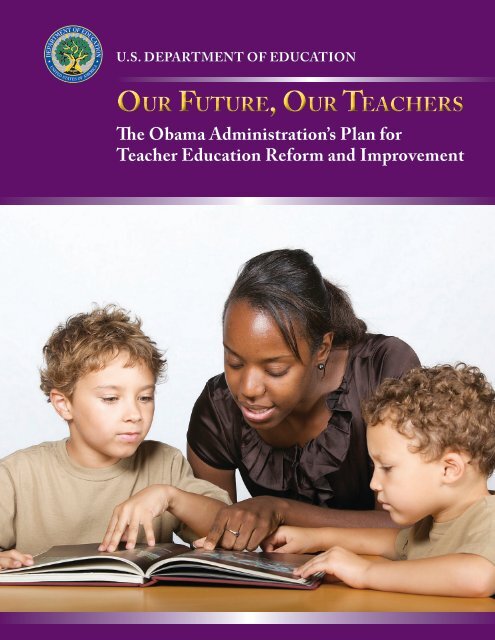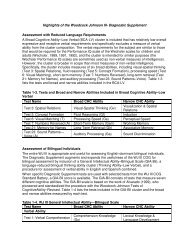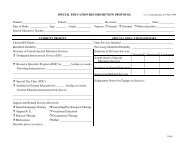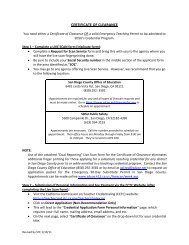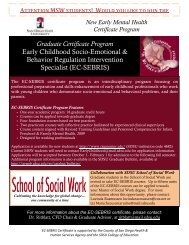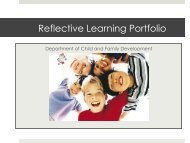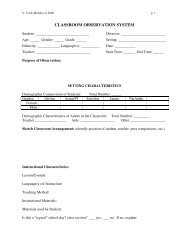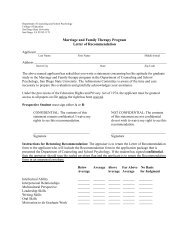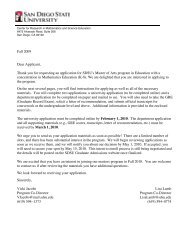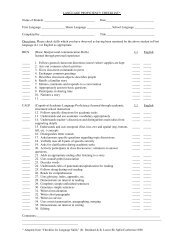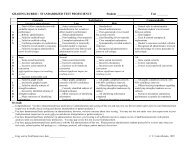Our Future, Our Teachers - U.S. Department of Education
Our Future, Our Teachers - U.S. Department of Education
Our Future, Our Teachers - U.S. Department of Education
You also want an ePaper? Increase the reach of your titles
YUMPU automatically turns print PDFs into web optimized ePapers that Google loves.
U.S. DEPARTMENT OF EDUCATION<strong>Our</strong> <strong>Future</strong>, <strong>Our</strong> <strong>Teachers</strong>The Obama Administration’s Plan forTeacher <strong>Education</strong> Reform and Improvement
<strong>Our</strong> <strong>Future</strong>, <strong>Our</strong> <strong>Teachers</strong>The Obama Administration’s Plan forTeacher <strong>Education</strong> Reform and ImprovementUnited States <strong>Department</strong> <strong>of</strong> <strong>Education</strong>September 2011i
U.S. <strong>Department</strong> <strong>of</strong> <strong>Education</strong>Arne DuncanSecretary <strong>of</strong> <strong>Education</strong>September 2011This publication is in the public domain. Authorization to reproduce it in whole or in part is granted.While permission to reprint this publication is not necessary, the citation should be: U.S. <strong>Department</strong> <strong>of</strong><strong>Education</strong>, <strong>Our</strong> <strong>Future</strong>, <strong>Our</strong> <strong>Teachers</strong>: The Obama Administration’s Plan for Teacher <strong>Education</strong> Reform andImprovement, Washington, D.C., 2011.This document contains contacts and website addresses for information created and maintained by otherpublic and private organizations. This information is provided for the reader’s convenience. The U.S.<strong>Department</strong> <strong>of</strong> <strong>Education</strong> does not control or guarantee the accuracy, relevance, timeliness, or completeness<strong>of</strong> this outside information. Further, the inclusion <strong>of</strong> information or addresses, or websites forparticular items does not reflect their importance, nor is it intended to endorse any views expressed, orproducts or services <strong>of</strong>fered.This publication is available at the <strong>Department</strong>’s website at http://www.2ed.gov/inits/ed/index/htmlii
ContentsFigures. . . . . . . . . . . . . . . . . . . . . . . . . . . . . . . . . . . . . . . . . . . . . . . . . . . . . . . . . . . . . . . . . ivSupport for Reform . . . . . . . . . . . . . . . . . . . . . . . . . . . . . . . . . . . . . . . . . . . . . . . . . . . . . . . 3The Challenge . . . . . . . . . . . . . . . . . . . . . . . . . . . . . . . . . . . . . . . . . . . . . . . . . . . . . . . . . . . 5The Opportunity . . . . . . . . . . . . . . . . . . . . . . . . . . . . . . . . . . . . . . . . . . . . . . . . . . . . . . . . . 7The Plan . . . . . . . . . . . . . . . . . . . . . . . . . . . . . . . . . . . . . . . . . . . . . . . . . . . . . . . . . . . . . . . 9iii
FiguresFigure 1. New <strong>Teachers</strong> Report Feeling Unprepared for “Classroom Realities” . . . . . . . . . . . . . . . . . . . . . . 5Figure 2. Low Performing or At-Risk Programs . . . . . . . . . . . . . . . . . . . . . . . . . . . . . . . . . . . . . . . . . . . 6Figure 3. A Comprehensive Agenda . . . . . . . . . . . . . . . . . . . . . . . . . . . . . . . . . . . . . . . . . . . . . . . . . . . . 9.Figure 4. <strong>Our</strong> teaching force does not reflect the increasing diversity <strong>of</strong> our students . . . . . . . . . . . . . . . . . . .13
“From the moment students enter a school, the most important factor in their success is not the color <strong>of</strong> theirskin or the income <strong>of</strong> their parents, it’s the person standing at the front <strong>of</strong> the classroom... America’s futuredepends on its teachers. That is why we are taking steps to prepare teachers for their difficult responsibilitiesand encouraging them to stay in the pr<strong>of</strong>ession. That is why we are creating new pathways to teaching andnew incentives to bring teachers to schools where they are needed most.”President Barack ObamaRemarks to the Hispanic Chamber <strong>of</strong> CommerceMarch 10, 2009ForewordArne DuncanU.S. Secretary <strong>of</strong> <strong>Education</strong>Over the next ten years, 1.6 million teachers will retire, and 1.6million new teachers will be needed to take their place. This posesboth an enormous challenge and an extraordinary opportunity forour education system: if we succeed in recruiting, preparing, andretaining great teaching talent, we can transform public educationin this country and finally begin to deliver an excellent educationfor every child.Supporting a strong teaching force and school leadership is a toppriority for the Obama administration. Making improvements in teacher and leader effectivenessis one <strong>of</strong> four pillars <strong>of</strong> the Administration’s education reform agenda. Unfortunately, our publiceducation sector has been among the hardest hit during these difficult economic times. That’s whyPresident Obama made it a national priority to ensure that teachers don’t lose their jobs because <strong>of</strong>state and local budget cuts, including a $30 billion fund to prevent teacher lay<strong>of</strong>fs in the AmericanJobs Act. This is just one <strong>of</strong> the many ways that we are working to support teachers and leaders inschools across the country; and we know much more work needs to be done to support teacherswhile in the classroom and to reward them like the true pr<strong>of</strong>essionals they are. Still, the first step iswith how we handle teacher preparation—what happens before many teachers even step foot in theclassroom.While there are many beacons <strong>of</strong> excellence, unfortunately some <strong>of</strong> our existing teacher preparationprograms are not up to the job. They operate partially blindfolded, without access to data that tellsthem how effective their graduates are in elementary and secondary school classrooms after theyleave their teacher preparation programs. Too many are not attracting top students, and too manystates are not setting a high bar for entry into the pr<strong>of</strong>ession. Critical shortage areas like science,technology, engineering, math, and special education are going unfilled. And too few teacherpreparation programs <strong>of</strong>fer the type <strong>of</strong> rigorous, clinical experience that prepares future teachers forthe realities <strong>of</strong> today’s diverse classrooms. Superintendents who hire large numbers <strong>of</strong> new teachers,as I did in Chicago, have been frustrated at having to retrain new teachers.
Still, I’m optimistic about what’s happening across the country. Thanks in part to investmentsthat our Administration has made to support new data systems, over a dozen states now linkteacher preparation programs with meaningful P-12 impact data on how their graduatesare performing in the classroom so programs can improve themselves. Investments in theAmerican Recovery and Reinvestment Act have supported dozens <strong>of</strong> colleges <strong>of</strong> educationacross the country as they develop new clinical programs that provide students with trainingin the concrete skills they will need to be effective in the classroom. Leaders from all teacherpreparation pathways, both traditional and alternative route programs are uniting around avision <strong>of</strong> teacher preparation that puts student results and effective teaching front and center.We want to build on this emerging consensus and on the reforms that our Administrationhas supported to re-design the No Child Left Behind Act and spur a Race to the Top inour schools. This package <strong>of</strong> teacher preparation initiatives will support and further thetransformation already underway in how we recruit and prepare teachers in this country.Under this plan, teacher preparation programs will be held to a clear standard <strong>of</strong> qualitythat includes but is not limited to their record <strong>of</strong> preparing and placing teachers who deliverresults for P-12 students. The best programs will be scaled up and the lowest-performing willbe supported to show substantial improvements in performance. Significant new scholarshipfunding will help recruit the next generation <strong>of</strong> teachers to attend the most successful teacherpreparation programs across the country. We will invest needed resources in developing ateaching workforce that reflects the diversity <strong>of</strong> our students. And standards for entry intoteaching will rise to a level worthy <strong>of</strong> this great pr<strong>of</strong>ession.<strong>Our</strong> goal is simple: We want every teacher to receive the high-quality preparation andsupport they need, so that every student can have the effective teachers they deserve. Thisadministration looks forward to working with Congress, with leaders in the fields <strong>of</strong> teacherpreparation and development, and with all who share this vision to bring this plan to life.
Support for Reform“We need to take the lead in recruiting and training teacher candidates. Let’sstart by giving them the best preparation anyone could imagine on the front end,before they ever set foot in a classroom. Students need and deserve our best effortsand our best educators. The Administration’s proposal <strong>Our</strong> <strong>Future</strong>, <strong>Our</strong> <strong>Teachers</strong>provides a strong roadmap for promoting and highlighting excellence inteacher preparation programs and providing long overdue support for teacherpreparation programs at minority-serving institutions.”Dennis Van RoekelPresidentNational <strong>Education</strong> Association“Research has shown that teachers are the most important school-based factor indetermining student achievement. Comprehensive teacher effectiveness reform mustinclude bringing accountability to teacher preparation. Ultimately, colleges <strong>of</strong> educationshould be reviewed the same way we propose evaluating teachers - based primarilyon student learning. We applaud the Administration for taking an important stepin advancing these reforms, collecting better outcome data, and supporting statereforms.”Chiefs for Change“Teacher preparation must, in the words <strong>of</strong> a recent NCATE Blue Ribbon Panel report,be ‘turned upside down.’ We have to raise the bar for teacher preparation so thatexcellent programs and practices are the norm across our nation. We applaud theefforts <strong>of</strong> the Administration in its strategic plan <strong>Our</strong> <strong>Future</strong>, <strong>Our</strong> <strong>Teachers</strong> to developa comprehensive agenda that will promote effective teaching at every stage <strong>of</strong> thecareer pipeline. We are eager to work together with the <strong>Department</strong> and with allstakeholders to build a new system <strong>of</strong> teaching effectiveness that serves all our nation’slearners.”James G. CibulkaPresident, National Council for Accreditation <strong>of</strong> Teacher <strong>Education</strong>President, Council for the Accreditation <strong>of</strong> Educator Preparation“<strong>Our</strong> <strong>Future</strong>, <strong>Our</strong> <strong>Teachers</strong> makes clear that the ability to teach is something to learn, andtherefore to be taught. This report puts the focus where it should be: beginning teachers’readiness to practice independently. Setting performance requirements for responsibleteaching is one <strong>of</strong> the most important improvements that the U.S. could make to ensurelearning by all students. Clear standards for what teachers should be able to do whenthey enter the classroom would shift the focus away from arguments over who shouldprepare teachers and how to select program entrants and toward beginning teachers’actual instructional skills. The Administration’s teacher education plan takes animportant stand -- it’s the outcomes <strong>of</strong> teacher preparation that matter most.”Deborah Lowenberg BallDean, School <strong>of</strong> <strong>Education</strong>University <strong>of</strong> Michigan at Ann Arbor 3
The ChallengeTeacher preparation programs play an essential role in our elementary andsecondary education system, which relies on them to recruit, select, and prepareapproximately 200,000 future teachers every year. 1 Strong programs recruit, select,and prepare teachers who have or learn the skills and knowledge they need to behired into teaching positions, be retained in them, and lead their students to stronglearning gains. Weak programs set minimal standards for entry and graduation.They produce inadequately trained teachers whose students do not make sufficientacademic progress.Unfortunately, while there are shining examples <strong>of</strong> strong programs throughoutthe country, too many <strong>of</strong> our teacher preparation programs fall short. As a whole,America is not following the lead <strong>of</strong> high-performing countries and recruiting thenation’s best and brightest into teaching. Instead, only 23% <strong>of</strong> all teachers, andonly 14% <strong>of</strong> teachers in high-poverty schools, come from the top third <strong>of</strong> collegegraduates. 2 <strong>Our</strong> differences with other nations are not due to teacher preparationalone. We must do more to support and reward excellent teaching at various stagesin the education system. However,we can do more in the area <strong>of</strong>preparation. After admission, toomany programs do not provideteachers with a rigorous, clinicalexperience that prepares them forthe schools in which they will work.Only 50 percent <strong>of</strong> current teachercandidates receive supervisedclinical training. More than threein five education school alumnireport that their education schooldid not prepare them for “classroomrealities.” 3Programs <strong>of</strong>ten do not respond toschool district needs for teachersprepared to teach in high-needsubjects like science, technology,engineering, and math, and highneed fields like teaching English1Julie Greenberg, Laura Pomerance and Kate Walsh, Student Teaching in the United States (Washington, DC: NationalCouncil on Teacher Quality, 2011), 1, http://www.nctq.org/edschoolreports/studentteaching/docs/nctq_str_full_report_final.pdf2Byron Auguste, Paul Kihn, Matt Miller, Closing the talent gap: Attracting and retaining top-third graduates to careers inteaching (Washington, DC: McKinsey & Company, 2010), 5,http://www.mckinsey.com/clientservice/Social_Sector/our_practices/<strong>Education</strong>/Knowledge_Highlights/~/media/Reports/SSO/Closing_the_talent_gap.ashx3Arthur Levine, Educating School <strong>Teachers</strong> (Washington, D.C.: The <strong>Education</strong> Schools Project, 2006), 32, http://www.edschools.org/teacher_report.htm5
The OpportunityDespite this grim picture, there are significant causes foroptimism. At the program level, Fayetteville State University, ahistorically black university with an acceptance rate <strong>of</strong> 61% andin-state tuition <strong>of</strong> less than $4,000, is preparing some <strong>of</strong> the mosteffective high school teachers in North Carolina. 7 At Kansas’Emporia State University, clinical training isn’t simply an “add on”semester after years <strong>of</strong> instruction in educational theory. Instead,academic training supplements an intensive and continuingclinical experience that begins in a student’s sophomore year andcontinues through to graduation. Additionally, some alternativepathway programs are attracting new talent into the pr<strong>of</strong>ession anddeveloping new models for rigorously preparing and supportingtheir teachers. Teacher residency programs in Boston, Chicago, andDenver are pioneering a new vision for preparing teachers and postingextraordinary early results – a vision strongly supported by the ObamaAdministration through the Teacher Quality Partnership grantprogram.At the state level, Louisiana and Tennessee have developedstatewide systems that track the academic growth <strong>of</strong> a teacher’sP-12 students back to the preparation program from which thatteacher graduated. North Carolina’s Institute for Public Policy hasdone the same for all public college teacher preparation programs inthe state. The picture these feedback systems paint <strong>of</strong> differentiationin teacher preparation program effectiveness is striking. InTennessee, after controlling for elementary and secondary studentpopulation differences, the most effective programs producegraduates who are two to three times more likely to be in thetop quintile <strong>of</strong> teachers in a subject area in the state, while theleast effective programs produced graduates who are two to threetimes more likely to be in the bottom quintile. 8 That’s powerfulinformation for hiring superintendents and for teacher preparationprogram leaders who can use the data to drive program changes andimprovement.Moreover, there are marked differences within institutions.Tennessee’s data suggest that while one <strong>of</strong> its colleges <strong>of</strong> educationexcels in producing high-performing math and science teachers, inthe past it has been less effective in preparing English language artsteachers. That’s important for the program to know in improvingits teacher preparation program and for public schools to knowwhen recruiting and hiring new teachers. The early lessons fromReports fromLouisiana“Louisiana was the firststate to systematically breakthe silos separating teacherpreparation and K-12 schools.Now, K-12 student results arelinked to teachers and mappedback to the higher educationprograms that prepared thoseteachers… I applaud the U.S.<strong>Department</strong> <strong>of</strong> <strong>Education</strong>for working to take theLouisiana-model nationwide.Teacher preparation programaccountability for K-12 resultsis an idea whose time hascome.”Paul G. PastorekFormer State Superintendent <strong>of</strong>SchoolsLouisiana <strong>Department</strong> <strong>of</strong><strong>Education</strong>“All adults, including thosepreparing teachers, must be heldresponsible for the outcomesin our public schools. We havewaited far too long… The U.S.<strong>Education</strong> <strong>Department</strong>’s planis right on target.”Diane RousselFormer Superintendent <strong>of</strong>Jefferson Parish Public SchoolsJefferson Parish, Louisiana7Fayetteville State University Office <strong>of</strong> Institutional Research, Fact Book Fall 2010 (Fayetteville, 2010),17,http://www.uncfsu.edu/ir/FactBook/ Fall_2010_Fact_Book_draft_copy.pdf8Tennessee Higher <strong>Education</strong> Commission, Report Card on the Effectiveness <strong>of</strong> Teacher Training Programs(Nashville, 2010), http://www.tn.gov/thec/Divisions/fttt/report_card_teacher_train/Report%20Summary.pdf7
“Teacher preparationhas been ‘shaken-up’ inLouisiana. We’ve livedthrough the difficult‘redesign’ years and we’recontinuing to work outthe kinks <strong>of</strong> the valueaddeddata system. Theproposed initiatives willprovide impetus to seekimprovement in newareas <strong>of</strong> need in teacherpreparation. . . . Bottomline: I support SecretaryArne Duncan’sinitiative.”Vickie S. Gentry, Ph.D.Dean, College <strong>of</strong><strong>Education</strong> & HumanDevelopmentNorthwestern StateUniversityNatchitoches,Louisiana“In the effort to assuredistricts that theirteachers will addthe most “value” tostudent achievement,preparation programshave been carefullyredesigned and someeven closed… TheLouisiana model isone...that should bereplicated in otherstates.”Tennessee, Louisiana, and North Carolina are informing work being doneby every Race to the Top winning-state developing similar feedback systemsand by states and teacher preparation programs across the country looking toupgrade their teacher training programs.In many ways, most heartening is that leaders within the teacher educationcommunity are recognizing the urgency <strong>of</strong> the challenges facing teachereducation and leading reform efforts. A recent Blue Ribbon panel convenedby the National Council for Accreditation <strong>of</strong> Teacher <strong>Education</strong> (NCATE)called for teacher preparation to be “turned upside down” and laid out anambitious plan for reforming programs through greater selectivity, morerigorous accountability, and a focus on clinical practice. 9 The AmericanAssociation <strong>of</strong> Colleges <strong>of</strong> Teacher <strong>Education</strong> (AACTE), which endorsedthe report, is working with 21 states to develop a teacher performanceassessment that will replace low-level pencil and paper licensure tests withan assessment built around high pr<strong>of</strong>essional expectations to which bothteachers and preparation programs would be held accountable. AACTEhas called for teacher preparation program accountability based on studentoutcomes as well as program input characteristics.The federal role is to support states in their work. It is not to usurp thesignificant progress already being made across the country. It is not toprescribe any particular model for how teachers should be prepared. Butthe right set <strong>of</strong> federal policies and investments can accelerate and supportprogress already underway, and the federal government can shine a spotlighton exemplary models for replication and scaling. It can and should addresschallenges that for too long have been neglected by supporting statelevelpolicies that reward the best programs, improve the mid-performingprograms, and transform or ultimately shut down the lowest-performers.8Barbara FreibergPresident, East BatonRouge School BoardEast Baton Rouge,Louisiana9Blue Ribbon Panel on Clinical Preparation and Partnerships for Improved Student Learning, TransformingTeacher <strong>Education</strong> Through Clinical Practice: A National Strategy to Prepare Effective <strong>Teachers</strong> (Washington, DC:National Council for Accreditation <strong>of</strong> Teacher <strong>Education</strong>, 2010), http://www.ncate.org/LinkClick.aspx?fileticket=zzeiB1OoqPk%3D&tabid=715
Scholarships. The vast majority <strong>of</strong> Presidential Teaching Fellow funds would go toteaching scholarships. States would give subgrant funds to top-tier programs regardless<strong>of</strong> pathway. In turn, top-tier programs would award final-year Presidential TeachingFellow scholarships <strong>of</strong> up to $10,000 each to high-achieving students with a priorityfor students from a low-income background. These students would prepare to teach ina high need subject, such as science, technology, engineering, and mathematics, or in ahigh-need field, such as teaching English Learners and students with disabilities, andwould commit to teaching for at least three years in a high-need school.PresidentialTeachingFellowsto receivea $10,000scholarshipand teach for3 years in ahigh-needschool.This program would be a revision <strong>of</strong> the existing TEACH Grant program, maintainingand strengthening the program’s core purpose <strong>of</strong> providing scholarships to recruitteachers to work in high-need schools. Under the current program, approximately$110 million a year in grants are provided to all teacher preparation programs, withoutconsideration <strong>of</strong> quality, and to students as early as their freshman year, before theymay have the maturity or experience to commit to the teaching pr<strong>of</strong>ession. As aresult, nearly 80 percent <strong>of</strong> recipients are expected not to fulfill their teaching servicerequirement and will have to repay their grant with interest. Further, <strong>of</strong> the few teacherpreparation programs that states currently identify as at-risk or low-performing, twothirdsreceive funds under the TEACH grant program. By targeting funds to top-tierprograms and to students in the final year <strong>of</strong> program participation, the PresidentialTeaching Fellows program will provide a strong incentive to graduating students andbetter ensure that program funds support individuals who fulfill their service requirementand enter the pr<strong>of</strong>ession with the skills, knowledge, and disposition to be effective teachersin high-need schools and subjects.Current TEACH grant recipients would continue to receive ‘grandfather’ aid for theduration <strong>of</strong> their academic program. All teacher candidates, whether or not theyattend a top-tier program, will have access to income-based loan repayment that capsmonthly federal student loan payments to 10 percent <strong>of</strong> income and public service loanforgiveness that wipes clean remaining federal student loan debt following 10 years <strong>of</strong>public service work, including teaching.12
III. Targeted Investments: Hawkins Centers for Excellence atMinority Serving InstitutionsWhile the HEA regulations and Presidential Teaching Fellows program will createconditions for reform for all programs and students in a state, targeted investmentsare also necessary. Research indicates that disadvantaged students benefit academicallyand socially from having teachers with whom they can identify. But such teachers areunderrepresented in the workforce: 14 percent <strong>of</strong> teachers identify as African-Americanor Hispanic, compared to 38 percent <strong>of</strong> students. Only 2 percent <strong>of</strong> teachers are African-American men and only 2 percent are Latino men. 11Minority-serving institutions (MSIs), which collectively prepare more than half <strong>of</strong> allminority teachers, must play a major role in preparing the next generation <strong>of</strong> effectiveminority teachers. While many MSIs struggle in significant part because <strong>of</strong> a lack <strong>of</strong>funds compared to peer institutions, a number <strong>of</strong> MSI teacher education programsdemonstrate better than average results despite being dramatically underfunded.According to a recent and extensive University <strong>of</strong> North Carolina study, FayettevilleState University, a non-selective and relatively low tuition school, consistently producesteachers who generate higher than average K-12 student academic achievement gains.Fayetteville State is more successful thancolleges with comparable incoming studentbody demographics and more successful than colleges that are have more selectiveadmissions requirements.11U.S. <strong>Department</strong> <strong>of</strong> <strong>Education</strong>, Secretary Arne Duncan’s Remarks to National Council for Accreditation <strong>of</strong> Teacher <strong>Education</strong>on 6 November 201013
To support teacher preparation programs at MSIs, the Administration is requesting$40 million for the Augustus F. Hawkins Centers <strong>of</strong> Excellence program. Thisprogram, authorized by Congress in 2008 but never before funded, would providecompetitive grants to teacher preparation programs at MSIs or MSIs in partnershipwith other institutions <strong>of</strong> higher education. These projects will undertake a series <strong>of</strong>reforms to be developed in consultation with leaders <strong>of</strong> preparation programs at thoseinstitutions. Potential reforms may include:$40million toupgradeandexpandMSIteachereducation.• Heightened entry and/or exit standards for teacher candidates;• Comprehensive interventions to help promising candidates meet heightenedstandards, particularly passing rigorous entry and licensure exams;• Redesign to ensure that programs are deeply, clinically-based with academiccoursework informing and supplementing field experience;• Training <strong>of</strong> all candidates in evidence-based methods <strong>of</strong> reading instructionand the use <strong>of</strong> data to drive classroom practice; and• Partnerships with local school districts or with non-pr<strong>of</strong>it organizations withdemonstrated experience and effectiveness in preparing and placing highqualitycandidates.Eligible institutions include Historically Black Colleges or Universities (HBCUs),Historically Black Graduate Institutions, Hispanic-serving Institutions, TribalColleges or Universities, Alaska Native-serving Institutions, Native HawaiianservingInstitutions, Predominantly Black Institutions, Asian American and NativeAmerican Pacific Islander-serving Institutions, and Native American-serving NontribalInstitutions with a qualified teacher preparation program. Consortia <strong>of</strong> MSIs as well aspartnerships <strong>of</strong> non-MSIs and MSIs together are also eligible to apply. The statutorilyrequired minimum grant is $500,000, but awards are expected to average $2 millionper year. Grants would be awarded for three years, with an additional two years <strong>of</strong>continuation funding available conditioned on meeting performance targets. Eligibleinstitutions may use up to 2 percent <strong>of</strong> the funds provided to administer the grant.14
The <strong>Department</strong> <strong>of</strong> <strong>Education</strong>'s mission is to promote student achievement and preparation for globalcompetitiveness by fostering educational excellence and ensuring equal access.www.ed.gov


